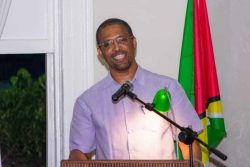In keeping with a CXC directive that from 2017 all School Based Assessments (SBAs) will have to be submitted online, the EGovernment Unit has started a project to link all secondary schools via the internet.
Head of the EGovernment Unit, Floyd Levi disclosed yesterday that so far 100 secondary schools along the coast have been connected with high speed internet access. These schools are located within the area that the network operates. “At this point in time those schools are using high speed internet access via the EGovernment network”, he said.
During a press conference at the Ministry of Public Telecommunications dealing with negotiations with a China-based technology company, Levi said that initially when the EGovernment network was operationalized, the focus was on government ministries and agencies, particularly those based in Georgetown and allowing them to be connected to their branch offices located outside Georgetown.
Levi said that one of the driving forces behind this project is that starting in 2017 the Caribbean Examinations Council (CXC) requires that all SBAs be uploaded via the internet. He said that this is the primary reason why secondary schools were targeted first.
He said that he has been advised by the Education Ministry that the CXC markers will now be required to do their marking via the internet. He said that in order to achieve this there needs to be some level of stability in the internet connection.
Public Telecommunications Minister Cathy Hughes added that “this is an incredible feat for us”. She said that this can begin the transformation that the government is hoping for.
She said gone are the days when families have to worry about being unable to afford text books.
She said now in many international jurisdictions students can find their text books on line. ‘For developing countries like Guyana that are dealing with several financial challenges it really can change the way we do a lot of things,” she said.
Over the next two weeks the Education Ministry will begin distributing laptops to teachers.
“The focus of this administration is ensuring that the laptops are given to teachers,” Hughes said.
The Ministry subsequently said in a press release that the schools are connected by the 4G LTE (Long Term Evolution) network which extends from Skeldon, Berbice to Charity, Essequibo Coast. It said that in addition, all high schools in Georgetown and its environs have also been connected to the fibre optic network that surrounds the city.
The Regional Democratic Council (RDC) offices in the respective regions have been connected to the same networks as well, it said, adding that Hughes sees this development as the beginning of a “long overdue process that will ultimately enhance ICT literacy across Guyana and improve our chances for rapid business development”.
The release added that the Project Management team in the EGovernment Unit, which operates under the umbrella of the ministry, announced last week that it had completed installing equipment to connect the computer laboratories at all secondary schools and the technical/vocational institutes in East and West Berbice and East and West Demerara. By the end of the week, all high schools in Georgetown and its environs had been connected, as were all technical/vocational institutes.
The latter include the Upper Corentyne, New Amsterdam and Mahaicony Technical Institutes in Regions 5 and 6; the Government Technical Institute, the Guyana Industrial Training Centre and the Carnegie School of Home Economics in Region 4; and the Leonora Technical Institute in Region 3.
The teams will very shortly move to Region 2, Essequibo Coast to connect approximately six schools before heading to the far inland areas and hinterland regions, the release said.
It stated that to date, sixteen schools in Region 6 including Tagore Memorial and the Winifred Gaskin Secondary have been connected. Seven secondary schools in Region 5 were linked up including the Mahaicony and Bygeval secondary schools. In Region 4 between Mahaica, ECD through Georgetown to Covent Garden Secondary, EBD, some 41 secondary schools have been connected to the fibre optic network. At West Demerara, eleven schools up to Parika are now joined to the internet via their computer labs and administration offices, it said.
“This initiative is a vital part of the Ministry of Education’s (MoE) five-year strategic plan which was drafted some years ago.
It was hinged on the operationalization of the ill-fated fibre optic cable that the previous government had ‘landed’ from neighbouring Brazil.
This cable was supposed to have been laid subterraneously along the Linden to Lethem corridor, then along the Linden/ Soesdyke Highway to connect with the fibre optic internet network in the city. [An]… analysis of the severely damaged cable is still in progress. Reports state that it was very badly handled by the contractors who should have buried the full length of the cable at least three (3) feet) below the top soil,” the release said.
Owing to the fact that this cable is currently unusable, the release explained that internet connection for schools and public service agencies in inland and hinterland communities will now take longer than the original MoE strategic plan for education connection had anticipated.
The Egovernment Unit, it said, is determined to satisfy the original MoE objective of completing the connection of all schools and institutes located within the radius of any LTE tower within the first two weeks of this 2016 Christmas term. The timeframe is mainly to accommodate students preparing for the next round of CXC examinations.








